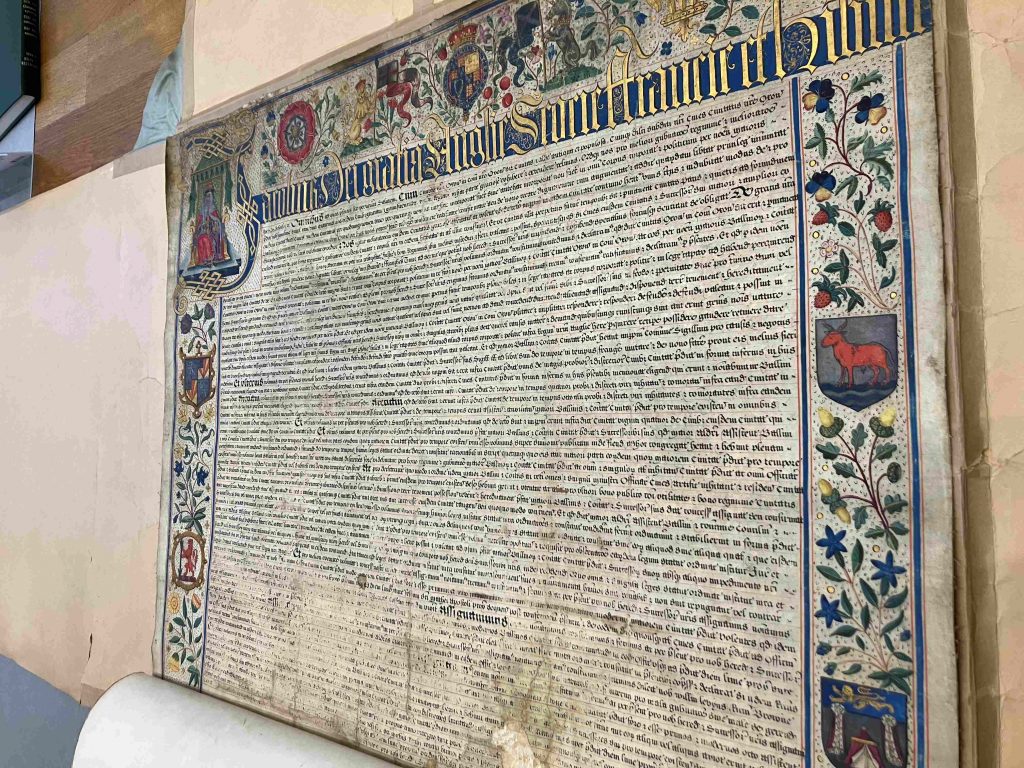The 1605 Oxford City Charter
 5 min read
5 min readThis photo depicts the 1605 Oxford city charter in which ‘for the first time the constituents and powers of the council were defined, and its election procedures described’.[1] As a result of this charter, Oxford became a corporate, free city, and as such, Oxford city corporation had the power to make by-laws, punish breaches by fine or imprisonment, sue and be sued in the corporate title, and be able to hold or dispose of property under a common seal.[2] This charter served as the foundation of civic governance in Oxford until 1835.

Oxford City Charter granted by James I, 1605. Reproduced by permission of Oxford History Centre. Photo taken by the author.
The 1605 charter is adorned with decorative borders that highlight the strong connection between the city corporation and the crown. Upon closer inspection, this charter does not just assert the authority of the crown but also appears to have been used as a heraldic device by the corporation to assert the authority and power of civic government. While the borders feature various symbols that promote the corporation’s ties to the crown, such as the harp, the city’s coat of arms is equally prominent. The coat of arms depicts a shield with a red ox, which symbolises courage and valour, especially in public office. Therefore, the symbolism within the coat of arms may have been a way for the corporation to assert its authority to the public. Further examination highlights that the charter is decorated extensively with what are called heraldic colours, including red, black, and yellow which were used not necessarily to reinforce the power of the crown but rather the civic virtues of the city government as in the case of black which often symbolised constancy and which it can be argued that the corporation expected the townspeople to emulate.
During the early seventeenth century, this document was employed by the corporation to strengthen its authority against objections from the university. By the 1630s, this document had become particularly significant as it enabled the corporation to challenge both the power of the university and the crown. It also helped establish the corporation’s authority over the townspeople, at least the freemen. This was a crucial objective for the corporation since the civic authorities were responsible for ensuring that the city was free from public disorder and unrest.
An example of how the charter was used to support the corporation’s authority can be found in the corporation minutes of 1636. At this time, the corporation refused to pay the full costs of accommodating the crown’s officers during the royal visit. The corporation’s minutes record that if this decision was challenged, they would display the charter in parliament and use it to support the mayor’s decision.[3]This refusal may have been due to the changing relationship with the crown in the 1630s, in which the corporation saw the gradual erosion of the liberties that had been granted in 1605 and was fighting to restore many of them.
In conjunction with the granting of the charter there was extensive financial investment made regarding the development of the town hall. This was due to the city corporation needing an appropriate symbol, of civic pride and authority due to this increase in power. If you want to find out more about how the town hall was used as part of the image making needed to legitimise this power, then further information on this is available as part of the town hall tour.
If you would like to know more about how Oxford city corporation exerted its authority by utilising civic culture have a look at the blog which is available on the museum website:
https://museumofoxford.org/i-see-mr-nixon-has-flown-the-fleeing-mayor-of-oxford
Written and researched by MOX volunteer Amy Moore
I recently completed my doctoral thesis, titled Oxford Town, Crown, and People 1575-1640, which focused on area underrepresented within the traditional historical narrative of the city, that of the role of urban civic government in state formation. I have also undertaken an internship with a community interest group called Uncomfortable Oxford which included writing an article for them in looking at women’s political participation within the city during the early modern period. My main areas of specialist interest are early modern towns and the state which has been influenced by my previous thirty years’ experience of working in local government.
Want to write your own Oxford-inspired post? Sign up as a volunteer blogger.
Sources
[1] Alan Crossley, ‘Early Modern Oxford’, in The Victoria County History of Oxford Volume IV: The City of Oxford, ed. by Alan Crossley (Oxford: Oxford University Press, 1979), pp. 74-181 p. 121.
[2] Crossley, ‘Early Modern Oxford’ p. 121.
[3] Herbert Salter, Oxford Council Acts, 1625-1665 (Oxford: Clarendon Press, 1932), pp. 67-68.
Copyright
© Oxford University
